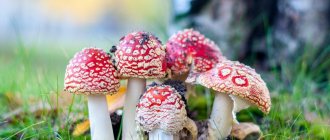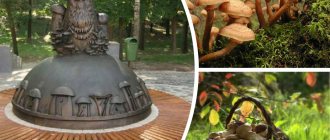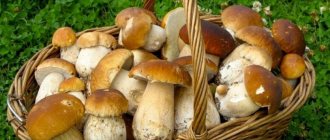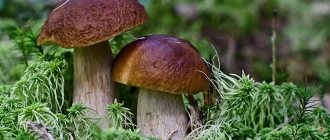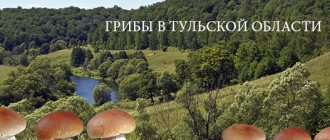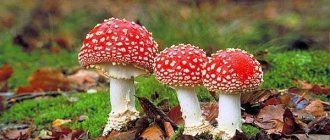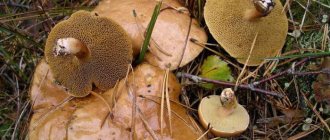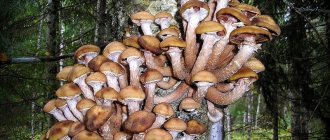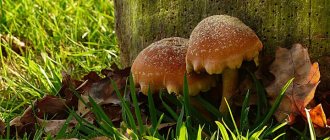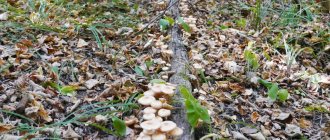Mushroom places in the Leningrad region 2022, today and now
Unfortunately, even from ancient times our grandmothers knew about the dangers of picking mushrooms. Most edible fruits have counterparts, similar in color and characteristic features. And in order to prevent a fatal mistake, both before and now, they knew the distinctive features. True, if previously information was transmitted based on the experience of elders, today you can find a detailed description with a visual photo, not only on the Internet, but also in a printed encyclopedia.
The modern world develops every year...as a result, nature suffers. Non-decomposing garbage, growing cemeteries, highways and factories have a detrimental effect on the quality of mushrooms. Their flesh, like a sponge, absorbs all poisons and carcinogens that can harm human health and life. To avoid poisoning and intoxication of the body as a whole, it is recommended to choose clean areas, refusing to collect old, wormy and fading fruits. Otherwise, even the most harmless mushroom can cause no less harm than one that is classified as poisonous and inedible.
Local residents, who have been versed in quiet hunting and collecting mushrooms in the Leningrad region for several years, always adhere to a simple rule - they collect forest gifts in places that have been tested over the years. This solution protects the body from exposure to toxins and carcinogens.
Among the best and most popular mushroom places in the Leningrad region, there is a rather long list. However, the following have been recognized as the most productive over the past few years:
1) Piozersky district. The forested areas of this area provide everyone with mushrooms growing in coniferous plantings. Hygrophores, milk mushrooms, boletus and saffron milk caps, rows and russulas are the main list of the riches of the popular territory.
2) Sosnovo. The countryside has always been famous for its clean air and fertile soil. Here is the ephedra in the direction from the Finnish Station in St. Petersburg, a magnificent pantry, famous for its fertile and simply edible mushrooms, belonging to three categories of consumption at once;
3) Vsevolozhsk district. The honorable “golden mean” in the TOP 5 list is occupied by one of the points farthest from the city. To get to the collection point, you will have to drive at least 110-120 km. Distance may vary from original location.
In order not to get lost in a vast area and calmly get out of the forest to your car without getting lost, you should put a point on the GPS navigator or Yandex (Google) maps in the application on your smartphone.
4) The splendor of the fauna of the village of Kirillovskoye has not left more than one person indifferent. And in combination with mushroom picking in the spring, summer and autumn months, it becomes a win-win option for outdoor recreation. Active walking, bending and squatting, in addition to eating food, will help you stay in shape.
5) Closes the TOP - Luga district. In past years, it remained no less popular, but only in September and October. In 2022, everything has changed! Since the onset of spring, local residents have noted the germination of strings, morels, and meadow mushrooms. There is hope that the summer months will bring quite a few boletus, milk mushrooms and Polish mushrooms.
About the artist
“The forest and nature have always been the most important and happiest part of my life. And among all the joys that the forest gives, mushrooms have caused me special delight since childhood. They have what awakens love: beauty and mystery. I have been drawing them for over thirty years. I began to see beauty that I had not noticed before. Now the humble russula can give me no less pleasure than a porcini mushroom. And the luxurious fly agaric mushrooms are a precious trophy for me. Like the people in the portraits, my characters are surrounded by objects from their native world: mosses, leaves, twigs.”
Alexander Vyazmensky – artist, naturalist, teacher.
“Alexander Vyazmensky (b. 1946 in Leningrad) is a master and popularizer of an amazing trend - botanical painting. His works are in many Russian and foreign collections, including the Minneapolis Institute of Arts, Farlow Library, Hunt Institute of Botanical Documentation (USA), London Botanical Garden, Lindley Library, Shirley Sherwood Collection (England), Grand Hotel Europe (St. Petersburg), private collections of America, England, Australia, Germany, the Netherlands. He illustrated the Red Book of Russia, the Red Book of St. Petersburg, the Red Book of the Novgorod Region and the Kola Encyclopedia. Airy and unusually realistic watercolors by Alexander Vyazmensky amaze with their scrupulous accuracy in conveying shapes and colors. His mushroom portraits are in perfect harmony with the white surface of the paper, giving the viewer’s imagination the opportunity to complete all the missing details of the forest where the depicted mushroom was found. And Alexander’s landscape sketches are not only mesmerizing, they beckon, calling you to kneel down and crawl to that tree, under which a porcini mushroom is hidden, covered with forest grass” (planet-gribov.rf - website of the St. Petersburg Mycological Society).
Conventional and edible mushrooms, where to look and collect?
In addition to the usual places that have been adopted in recent years, more experienced mushroom pickers can go looking for mushrooms in “secret” places. You shouldn’t think that their territories are classified on the map; it’s just that lovers of quiet hunting, who have been collecting mushrooms for many years, highlight the most fertile points for themselves, returning there every year. The coming year is no exception to the rule! Some collect full buckets, others leave the forest with empty baskets.
When going in search of certain types of mushrooms, it is recommended to make the right choice in favor of coniferous or deciduous plantings. An alternative would be a mixed zone, implying the presence of both trees.
Helpful information!
To collect mushrooms for pickling for the winter, it is recommended to take a knowledgeable mushroom picker with many years of experience with you on the search. He will help you decide on a place for a quiet hunt, and most importantly, he will share secrets and subtleties during the collection. If you don’t have such an acquaintance, you can try asking on social networks that fishing enthusiasts take a newcomer for company. Women are better off turning to the fair sex or married couples for their safety.
About the places where honey mushrooms grow
It would seem that it is easier to find honey mushrooms than steamed turnips: purely logically, they should be in any forest in which their potential host plants grow. But in reality, everything turns out to be more complicated: we are surrounded by giant forests, but no matter where honey mushrooms are found in them, but only in special places - which are “registered” with seasoned mushroom pickers and are strictly classified.
Why is that? The thing is that trees and shrubs have existed side by side with parasitic fungi for millions of years, and over this very considerable period they have “learned” to defend themselves quite successfully from them.
The first bastion of this defense is the bark, which is essentially an armor through which no spores can grow. If the tree bark is intact, then it is not afraid of parasitic mushrooms.
If suddenly the bark is damaged, then a second means of defense comes into play - chemical substances that suppress the development of fungi (garden fungicides are a kind of analogue of these substances). Any plant secretes especially a lot of these substances at a young age - when it develops intensively.
Therefore, in places where the trees are young and healthy, honey mushrooms are unlikely to bear fruit, it most likely makes no sense to look for these mushrooms there.
But where the trees are old or damaged, where there are stumps, fallen trunks or dead wood, honey mushrooms, as a rule, develop “with a bang” and throw out their fruiting bodies quite quickly. If you want to find them, go to some old forest, for example, with huge birch trees, whose trunks are 80 centimeters in diameter
And pay attention to the butt and roots of these very trunks - if they are quite overgrown with moss and lichen, it means that all the necessary conditions for mushrooms have been met. Here honey mushrooms grow not only on the bark of old trees (sometimes “climbing” very high), but also on their roots, so they can often be seen not on the trunk, but right on the ground
The next places where you can successfully collect honey mushrooms are clearings, and it doesn’t matter at all whether they are fresh or old. Although it has been noted that honey mushrooms grow more intensively in ancient clearings, the fact that the first fruiting bodies appear on the stumps a little more than six months after logging is known for certain.
In places where the felling of trees occurred for natural reasons - from the wind, for example, honey mushrooms also appear quite quickly. Therefore, any areas of the forest littered with windfall also need to be inspected during collection.
From my own experience, I can also add the following: honey mushrooms (at least ours - the Ural ones) do not particularly like places well warmed by the sun. They definitely prefer shade and some coolness, so you should look for them on the northern slopes of the mountains, in logs or ravines, as well as in spruce forests mixed with other trees.
In such places, I often observed breathtaking accumulations of mushrooms that covered everything with an orange carpet - stumps, the base of trees, fallen trunks, and the forest floor. From one average stump it was possible to easily cut a whole basket of honey mushrooms.
The main thing is to be in such a place on time - when the fruiting bodies are still small, tender, and have not developed into “burdocks”, at the same time becoming tough and inedible.
Forum, what do they write? Have the mushrooms gone or not?
It is almost impossible to give an exact answer to the question posed. If the fruiting season is just beginning, you should follow reviews and messages on forums and VKontakte groups. They will tell you the beginning of the collection, and possibly the coordinates where you should go in search. But if there is no such information, it’s worth looking at the photo of the map and deciding which mushrooms you’re most interested in:
- winter, summer and autumn honey mushrooms;
- porcini and Polish mushrooms;
- rows and russula;
- saffron milk caps and boletus;
- the first spring mushrooms - morels or strings;
- oyster mushrooms;
- dung beetles;
- hygrophores;
- waves;
- Champignon;
- white and black milk mushrooms;
- flywheels.
If you have a trained pig or dog, you can go searching for truffles. The delicacy, not only in name and aroma, but also in taste, has always been valued by chefs and gourmets, and most importantly, it was found in the Leningrad region. And this fact has been repeatedly confirmed on social networks. Many people rightfully go on a search because of the high cost of the product in order to use the dug up trophy as a product. The “gold bar,” if translated into finance, serves as a means of enrichment and financial well-being for many. And although it is difficult to obtain, experienced truffle hunters are not deterred by difficulties on the way to their goal.
Inedible and poisonous mushrooms can be found in any city and country. Some people use them to prepare tinctures for rubbing sore limbs, treating oncology and other problems. But if you have no experience in witchcraft, collecting dangerous fruits is not recommended. Even a small piece can cause poisoning and intoxication of the body. In the case of toadstool or fly agaric, the minimum amount is enough to cause death.
Autumn, summer and winter honey mushrooms: time difference
Autumn honey mushrooms, like winter ones, prefer deciduous wood and settle on both dead and living trees.
Winter honey mushrooms appear in waves with an interval of 15 to 20 days during the cooling period - at the end of August. And they can grow until the end of October. Until this month, you can also collect summer honey mushrooms, which can be found in abundance on rotting wood, most often on birch. But unlike autumn and winter ones, they begin to grow from the very beginning of summer.
The season of winter mushrooms occurs at the end of autumn, but during thaws they also develop in winter. Fruiting in flammulina can last from the end of September until May, but much in this case depends on the characteristics of the region of growth and temperature conditions.
Mushroom map of the region in the photo
If you want to go on a quiet hunt in 2022, it is recommended to look at the mushrooms bearing fruit over a vast area in the Leningrad region. The map of the area in the photo will tell you the directions for travel, both by personal car and by public transport.
The list of best options to consider includes:
1) the village of Sosnovo, distinguished by a rich mixed forest with coniferous and deciduous trees; 2) Karelian Isthmus; 3) the village of Kolchanovo, remote from the city; 4) Priozersky district; 5) an unusually beautiful lake called “Mirror”; 6) fauna of Kingisepp and surrounding areas.
An alternative to the listed options would be the village of Berngardovka and small forest belts with plantings of young trees, the age of which does not exceed 10-15 years. The deciduous zone will allow you to collect a rich harvest of honey mushrooms and rows, as well as noble mushrooms: porcini and Polish, milk mushrooms and champignons.
Another option for a quiet hunt would be a trip to Syavino. The village with a small forest of pines and spruces is one of the best deposits of boletus, spruce mushrooms and even hygrophores.
To hunt chanterelles in the Leningrad region, you can look for fruits in mixed forest belts. As practice shows, most often the “red pranksters” hide in the tall grass.
Tips for mushroom pickers
The first thing that comes to the mind of an inexperienced mushroom picker is to look for information on the Internet or ask the local population. Both options are acceptable, just remember that not everyone is willing to give away treasured places rich in mushrooms.
Tips to help in your search:
- You shouldn't look in dry grass.
- An older tree means more fungi (a more developed root system and a well-developed mycorrhiza that has been formed for a long time).
- The thicket of the forest is full of wild animals - it’s better not to go there. Myceliums are located on the edges, in clearings where deforestation took place, as well as near swamps.
Irina Selyutina (Biologist):
When going for mushrooms, remember:
- It is better for an inexperienced mushroom picker not to do this alone. When you go in company with someone, the likelihood of losing each other is significantly reduced, but finding a way out increases.
- When entering the forest, be sure to pay attention to where the sun is: if it was behind you, then you need to go out so that it shines in your eyes.
- The main reference point may also be road noise.
- It is best to look for boletus in young pine forests.
- Porcini mushrooms love mature, spruce or pine forests.
- Honey mushrooms are found where there are dead trees (mostly deciduous trees).
- Saffron milk caps simply adore young plantings of spruce and pine trees.
- They prefer light mature forests.
And never forget: If the summer or autumn turns out to be dry, you should not immediately go for mushrooms as soon as they appear after the first rains: there is a high probability that the vegetative body of the mushroom (mycelium) has absorbed toxic compounds that entered the soil with rainwater. Wait for the next rain.
Reviews, photos and videos
To find out in more detail about the treasure trove of mushrooms in the Leningrad region in 2022, you should not only read real reviews and opinions of experienced mushroom pickers, but also look at photo reports and videos shown on the Internet. Open access will help you determine your personal opinion on yield, confirming or denying the high yield that has persisted for many years in the region.
Regardless of whether the choice was made for noble, edible species of the second and third categories or just conventional mushrooms, if the weather and time of year are favorable, the harvest will be harvested in sufficient quantities to not only cook dinner, but also to fill the jars with marinade.
Regardless of the year and month, there were and will be mushrooms in the Leningrad region. And 2022 will be no exception to the rule! Many mushroom pickers have already managed to collect a good harvest, sufficient for canning.


